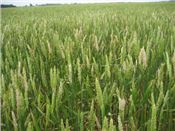The Best Management Of Fusarium Head Blight Of Wheat Starts With The Selection Of Varieties With Resistance
DR. CARL A. BRADLEY
PRINCETON, KENTUCKY
The most consistent, problematic disease of wheat in Kentucky and the surrounding region is Fusarium head blight (FHB; also known as scab), caused by the fungus Fusarium graminearum (Figure 1). This disease can cause reduced grain yield, test weight, and quality. In addition, the fungus can produce toxins that will contaminate grain, such as deoxynivalenol (DON; also known as vomitoxin). Harvested grain with high levels of DON may be discounted or outright rejected at the elevator.
To achieve the best management of FHB, the most important step is to choose varieties that have resistance to this disease. Unfortunately, varieties with complete resistance (immunity) to FHB do not exist, but there are several varieties available with high levels of resistance.
In addition to the ratings available from seed companies, the University of Kentucky Small Grains Variety Testing Program and the UK Small Grains Breeding Program do provide ratings for diseases that occur in their trials. Those disease results are available in the most recent KY Small Grain Variety Performance Test Report and on the Fusarium Head Blight (Head Scab) – Variety Testing Research Page, which both can be accessed here. In addition, the University of Illinois Wheat Breeding Program also provides similar ratings from their annual tests under FHB pressure, which are available here.
Seeking out this information and making good wheat variety decisions will go a long way towards managing this important disease. ∆
DR. CARL A. BRADLEY: Plant Pathology Extension Specialist, University of Kentucky

Figure 1. Symptoms of Fusarium head blight of wheat
Photos: Carl Bradley, UK